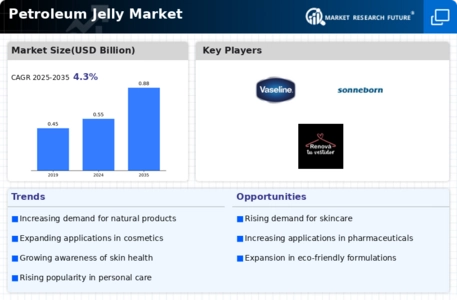Petroleum Jelly Size
Petroleum Jelly Market Growth Projections and Opportunities
The petroleum jelly market is influenced by several key factors that impact its growth, demand, and overall dynamics. One significant factor driving the market is the widespread use of petroleum jelly across various industries and applications. Petroleum jelly, also known as petrolatum, is a versatile product with numerous uses in skincare, pharmaceuticals, cosmetics, and industrial applications. In skincare, it is commonly used as a moisturizer, skin protectant, and wound healing agent. In pharmaceuticals, it serves as a base for ointments, creams, and topical medications. In cosmetics, it is used in lip balms, lotions, and makeup products. Its wide range of applications and effectiveness contribute to its high demand in the market.
Technological advancements also play a crucial role in shaping the petroleum jelly market. Innovations in manufacturing processes, refining techniques, and product formulations contribute to improving the quality, purity, and performance of petroleum jelly products. Advanced refining methods help remove impurities and enhance the clarity and consistency of petroleum jelly, making it more suitable for pharmaceutical and cosmetic applications. Additionally, advancements in packaging technology and sustainability practices contribute to the market's growth by improving product shelf life, safety, and environmental impact.
Market factors also include regulatory policies and quality standards governing the production, labeling, and marketing of petroleum jelly products. Regulatory agencies such as the FDA (Food and Drug Administration) in the United States and the European Commission in Europe set standards and requirements for product safety, purity, and labeling. Compliance with these regulations is essential for manufacturers to ensure consumer safety, product quality, and legal compliance. Moreover, adherence to industry standards and certifications, such as ISO (International Organization for Standardization) and GMP (Good Manufacturing Practice), enhances consumer trust and market credibility for petroleum jelly products.
Economic factors such as GDP growth, disposable income, and consumer spending influence the demand for petroleum jelly products. During periods of economic prosperity, increased consumer purchasing power and spending on personal care and healthcare products drive market growth. Conversely, economic downturns or recessions may lead to reduced consumer spending and demand for discretionary items, affecting the petroleum jelly market negatively. Moreover, fluctuations in crude oil prices, which impact the cost of raw materials for petroleum jelly production, can affect pricing strategies and profit margins for manufacturers.
Raw material availability and pricing are critical market factors for the petroleum jelly industry. Petroleum jelly is derived from petroleum, a fossil fuel, through a refining process that removes impurities and yields the final product. Therefore, fluctuations in crude oil prices and availability can impact the cost of raw materials and production costs for petroleum jelly manufacturers. Additionally, sourcing high-quality petroleum feedstock and ensuring a reliable supply chain are essential for maintaining product quality and meeting market demand.
Consumer preferences and trends also shape the petroleum jelly market landscape. With increasing awareness of skincare and personal grooming, consumers are seeking products that offer hydration, protection, and nourishment for their skin. Petroleum jelly's long-standing reputation as a gentle and effective moisturizer appeals to consumers looking for affordable and multipurpose skincare solutions. Moreover, the growing demand for natural and organic products has led to the development of petroleum jelly alternatives derived from plant-based or renewable sources, creating competition in the market.
Competition within the industry also influences the petroleum jelly market dynamics. With numerous manufacturers and brands offering petroleum jelly products, competition can be intense, leading to price competition, product innovation, and marketing efforts to differentiate brands and gain market share. Companies may differentiate themselves through product quality, packaging, branding, distribution channels, and marketing campaigns. Moreover, strategic partnerships, acquisitions, and expansions into new markets or product categories may help companies strengthen their competitive position and expand their market presence.



 Source: Secondary Research, Primary Research, Market Research Future Database and Analyst Review
Source: Secondary Research, Primary Research, Market Research Future Database and Analyst Review



Leave a Comment